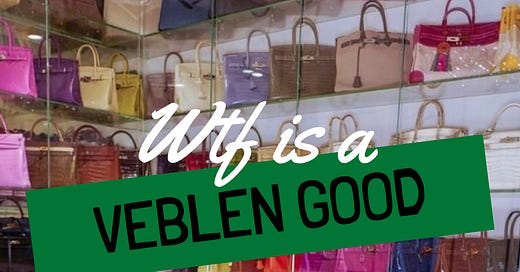A few weeks ago, a Consumer Digest reader slid into my inbox with a simple request: “Can you talk about Veblen Goods?”
To which I replied, “#FakeFan—I have! Briefly, anyway.” I first mentioned these ornaments of status in one of the early newsletters on Hermès and the Diminishing Marginal Returns of Exclusivity.
But as Chief of the Chic, Conscious Consumers, I take my responsibilities seriously—so here it is, a full look at Veblen Goods: the paradoxical products that make luxury make sense (or nonsense, depending on how you see it).
So today we’ll talk about those graphs and curves and you’ll be armed with a designer bag and $42 lip gloss in one hand and economic theory in the other.
Let’s digest!
Your Starter
Let’s start with what I call the Adam and Eve of Economics- supply and demand. This is the first story of Economics, much like The forbidden fruit, a good restricted from Adam and Eve, this restriction exacerbated by the trees low supply. The rule of supply and demand explains that as supply increase demand decreases, so there’s an inverse relationship between the two.This high restriction and low supply made the desire for the fruit insurmountable. Now this biblical example is void of what’s really holding people back from consuming products– not the word of god but the weight of their wallets.We could argue the weakness of the first humans lead to the existence of markets and prices but for now we’ll just get to what you came here for– Veblen Goods.
A Veblen Good is a rare creature in economics—one that defies the basic law of supply and demand. Normally, price and demand have an inverse relationship, as prices go up and demand goes down.That’s the gospel, right? But Veblen Goods do the opposite. The more expensive they get, the more people want them.
If supply and demand is the Genesis of Economics, Veblen Goods are the forbidden fruit: highly restricted, wildly desired, and capable of making people do irrational things in the name of prestige. (Only instead of divine punishment, the real barrier here is your credit limit.)
This upside-down logic is why Veblen Goods are so interesting—they flip the script. As price increases, so does demand. Why? Because the price is the point.
Let’s be real: Would a Birkin still be a Birkin if it cost $400 and came with Amazon Prime shipping?
Status, Scarcity and the "Chic, Conscious Consumer"
Sure, a few of us might say, “I’d still love my luxury items even if they were cheaper,” and that can be true. But in the broader consumer market, what matters most isn’t always quality, heritage, or even ethics—it’s brand name, recognition, and perception.
Let’s put it this way: If quality was the sole metric of value, half of the upper class would be driving 2004 Honda Civics- I mean those things have more lasting power than Rasputin!
And this is where we introduce a new kind of buyer: the aspirational consumer. They may not own a Birkin (yet), but they’re fluent in the resale market, watch every luxury unboxing on TikTok, and know the price of a Patek down to the penny. Their desire drives hype. Their engagement—likes, comments, saves—generates social proof. This visibility shapes the purchasing behavior of actual customers, who often buy status symbols not to enjoy them privately, but to be seen owning what others only dream of.
In the Veblen economy, perception is currency.
I’d describe this as social demand, as price increases, social demand increases.These goods can also be described as social goods, their value is partly determined by their social relevance and standing. The social demand of consumers explores that for Veblen Goods it's not just about the repeat customers, who have the capital to purchase these ornaments of status and use them to tell the world what they are- yes, what not who.
This creates a Consumption Loop:
Aspiration → Attention → Perceived Value → Real Demand.
Main Course: The Algorithm Is the New Atelier
Social media has stripped away the mystery once guarded by high-gloss fashion campaigns and velvet-rope boutiques. Now, anyone can learn the bezels released at Geneva’s Watches and Wonders or how long the waitlist is for an Hermès quota bag.
And this knowledge? it’s marketing.
Seeing the price tag on someone’s wrist or shoulder reinforces its value. “If that Rolex costs $10,000, it must be worth $10,000,” we think. This marketing creates a kind of confirmation bias that supports what James Duesenberry once coined the Relative Income Hypothesis: our spending habits are more influenced by our peers than by our actual income.This theory is often called “ Keeping up With the Jonses’” — but the old cliché used to be about peeking over your neighbor’s fence. Now it’s scrolling through their FYP.
Translation? If everyone around you owns a luxury watch, you’ll probably buy one too—even if it makes no financial sense—because belonging is priceless (and very expensive). In the Veblen economy, perceived status drives real purchases, and social media approval is just as influential as paying customers.
Even if those skeptical consumers aren’t buying Birkins or Pateks themselves, their perception still shapes the market. Why? Because luxury customers don’t just buy what they like—they buy what society signals is valuable. If the broader culture begins to question the authenticity or prestige of a brand, the desire to own it weakens across the board. The perception of value, not just the product itself, is what drives the sale.
Consumer’s as The Catalyst for Demand
The social demand driving the luxury market became crystal clear when social media lit up with claims that European fashion houses were secretly manufacturing their goods in China—allegedly exposed by Chinese retailers. While the rumors remain unconfirmed, the frenzy struck a nerve. For consumers who romanticize Veblen Goods, it shook the pedestal these brands sit on, unraveling the mythology that justifies their sky-high price tags. And here’s the real impact: even if most people will never afford a Birkin or a Patek, their perception still influences the value of those items in the market. Because if the illusion of exclusivity cracks—even slightly—the status starts to slip.
We all know exclusivity is the lifeblood of luxury, whether it’s born from scarcity, sky-high pricing, or meticulously controlled distribution. Once something feels accessible, it loses its allure. If fashion content makes the Birkin seem commonplace—seen on every influencer’s feed, rumored to be made in mass factories—its prestige begins to erode. As explored in an earlier Consumer Digest post, luxury dies not with lack of demand, but with loss of reverence.
Take fur, for example. Fur is undeniably expensive—out of reach for most people. But even among those who can afford it, it’s lost its place atop the hierarchy of status. Why? Because society collectively redefined what should be admired. Ethical concerns replaced aspiration. Fur didn’t fall out of fashion because of price or availability—it fell because the public stopped valuing it. The pedestal disappeared. So the wealthy followed suit. It was no longer a socially validated symbol of wealth, even if it still cost like one.
This same dynamic plays out across the luxury market: what society deems aspirational directly shapes what the affluent are willing to buy. In other words, social perception creates real market consequences.
And while aspirational consumers—those who can't afford the good but obsessively engage with it—aren’t spending (yet), they’re still influencing. Their tastes, values, and critiques feed into the algorithm, the conversation, and the cultural temperature. This not only informs their future purchases but has a direct impact on what current customers choose to buy right now.
Because here’s the truth: status is only meaningful in comparison. It has to be seen, ranked, and admired to matter. And if status is based on perception, then luxury brands are at the mercy of those watching from the outside just as much as those buying from within.
Veblen goods don’t just sell prestige—they depend on others believing in it. And in the age of hyper-visibility, that belief can unravel fast.
Secret Menu Item
In true Phia fashion, allow me to offer an “Off Menu Item”—an unexpected detour, but stay with me.
This meme first sparked conversation on Nigerian Twitter before going global. On the surface, it’s about clarity in manifestation: both vehicles are technically Mercedes-Benz, but one is a G-Wagon—a status symbol with seat warmers and Apple CarPlay—while the other is a workhorse truck, functional but far from aspirational.
The first tweet reflects classic materialism: dream big, but be specific. The subtweet flips the lens, reframing the utilitarian truck as an income-generating asset, and the luxury SUV as a depreciating liability. Back in the 2010s, this was the prevailing wisdom—A is for flexing, B is for building.
But in the 2020’s that may not be the case.Why is that? Social media.
In an age where content is currency, the visual language of luxury is the product. People are hungry for glimpses into aspirational lifestyles: the cars, the marble kitchens, the “get ready with me”s filmed in designer robes. Veblen Goods now double as tools of influence. Post the right luxury aesthetic and your following grows— evident in the content of Becca Bloom and Chloe L on Tiktok. The once-passive purchase becomes a monetizable prop. Visibility breeds value. In this economy, clout is collateral.
So yes, B can still buy A.
But A might now have the power to buy B back.
I could go on trying to explain how showing off ornaments of status on the internet turns them into assets but instead watch this video from The Hall Family. Which proves sometimes you gotta fake it til you make it.
Furthermore, it reveals that consumption doesn’t stop at the point of purchase—it’s repackaged, performed, and broadcast for an audience. In today’s market, buying the new Dôen x Gap collection isn’t the final act—it’s the prelude. The real value is unlocked when you post the try-on haul, tag the brands, and invite others to engage. This digital display amplifies the product’s perceived worth, transforming personal consumption into public, social currency and eventually financial currency once you’ve built a following. As described in Consumer Digest’s “Consuming Under The Influence”
Dessert and The Final Flex: Owning What Others Can’t
I think the standout point is that modern consumer culture is a bit different than we are often led to believe. The consumer, especially in the case of Veblen Goods can sometimes be more important to a brands social positioning than the actual customers, their perception of brand is what generates its value and standing. This is empowering to realize, its not just about economic transactions but also social interactions, media engagement and public perception.
Veblen Goods—Birkins, Rolexes, Pateks—aren’t just luxury items. They’re social signals. They whisper (or shout), I belong to a world most only dream about.
Luxury, in this world, isn’t about utility. It’s about symbolism. Being seen. Being envied. Being rare.
As Patek famously says: “You never actually own a Patek Philippe. You merely take care of it for the next generation.”
But let’s be honest…
There is also the perk of flexing it for the current one.
Thanks for Consuming!
Phia
“Each Day Gets Better”









💁🏾♀️
Always soooo good Phia 🙏🏻